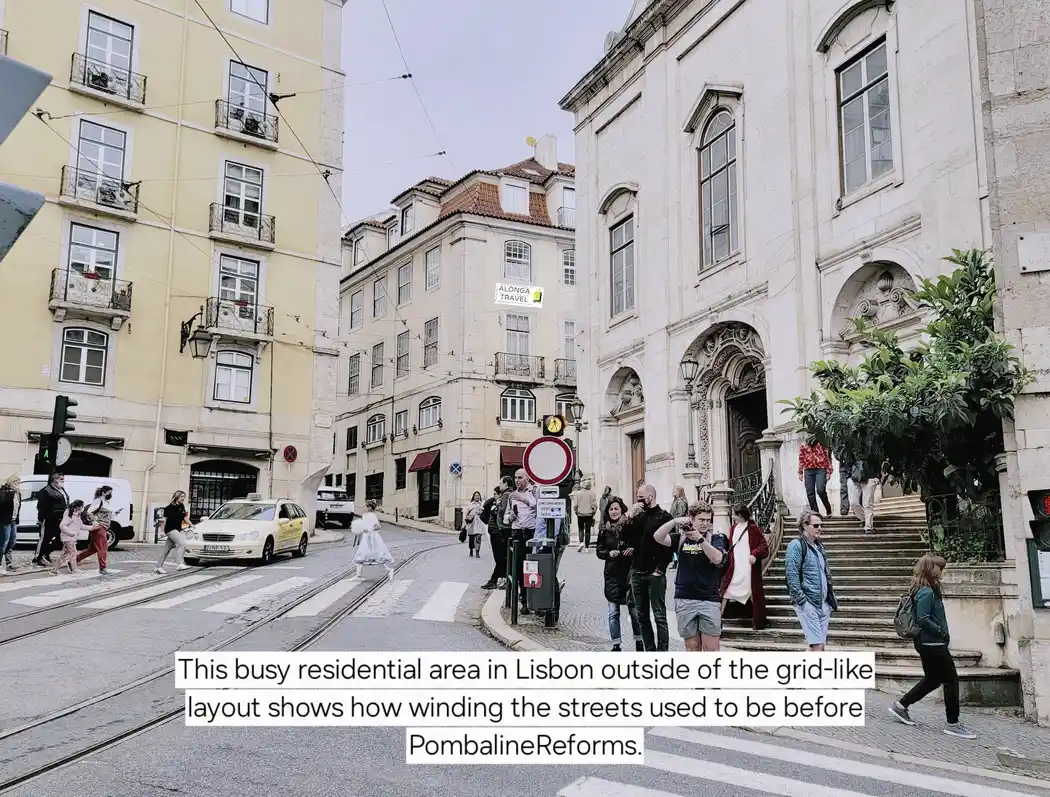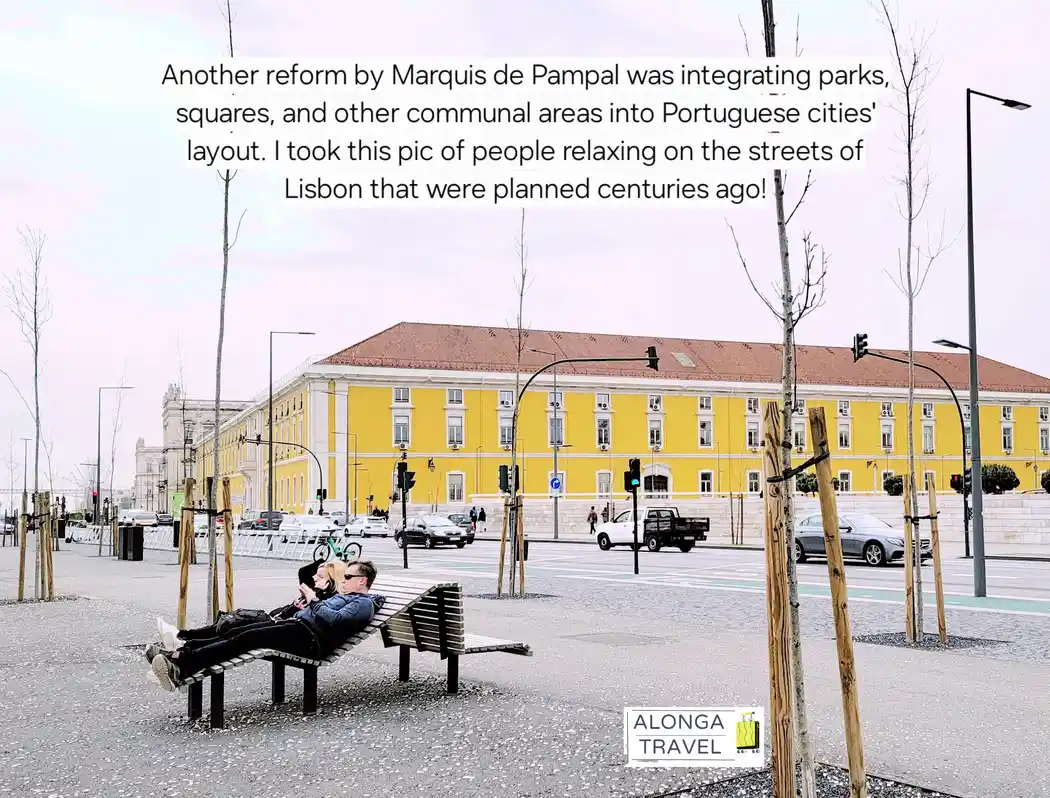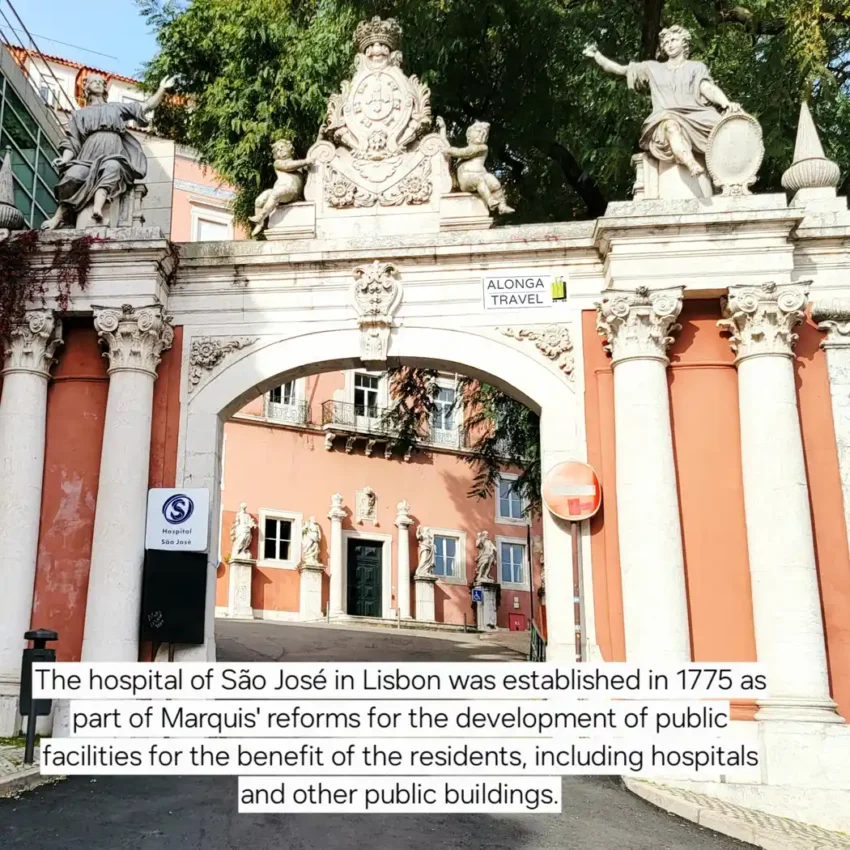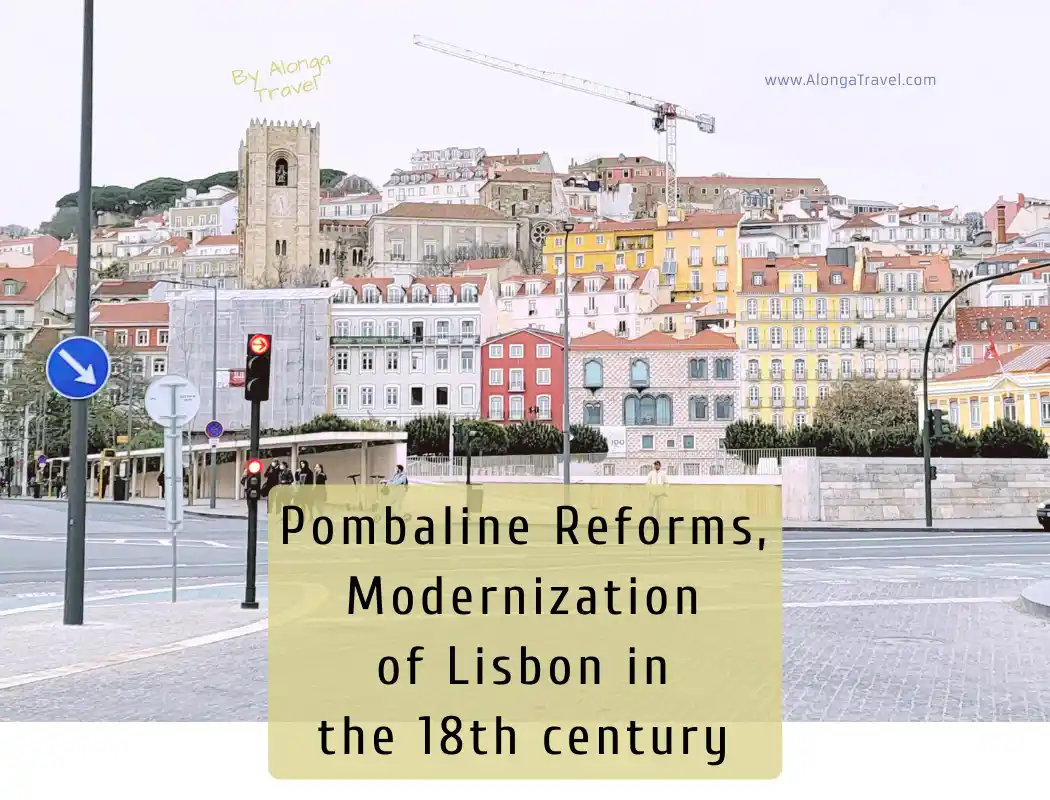It’s amazing how Pombaline Reforms Have changed Lisbon! Learn about what they did.
Pombaline reforms in Lisbon around 1755-1777 significantly improved Lisbon’s urban planning, infrastructure, governance, trade and education. They were introduced by the Marquis of Pombal in response to the devastating Lisbon earthquake. The aim was to not only rebuild the city but also improve the overall living conditions and stimulate the economy.
Beyond their impact on Lisbon, the Pombaline reforms had far-reaching effects in Portugal and its colony, Brazil. However, they faced opposition from the nobility and the Catholic Church, making them controversial.
Let’s look deeper into the impact of these reforms on Lisbon and how they modernized the city. When you visit many attractions in Lisbon, you will be able to understand their history and why the streets look the way they are.
But first, it is important to understand the role of Marquis de Pombal. Who was the Marquis of Pombal?
Hi, I’m Tatiana. I show my experience from my daily walks in new cities/countries/areas (I’m a nomad), where I look for places with fun architecture, beautiful old buildings, lovely vibe & pretty scenes. I find the best destinations to visit in Europe and beyond & I record everything.
Marquis de Pombal
Marquis de Pombal was a prominent figure in Portuguese history during King José I’s reign. He made changes to how cities were planned, buildings were constructed, how trade was conducted and education was carried out, and how knowledge was shared.
These changes were made to make Lisbon more modern and keep up with the times.
Sebastião José de Carvalho e Melo (1699-1782), who later became known as the Marquis of Pombal, was given this title for his work and help to the Portuguese kingdom. He was also called the 1st Count of Oeiras.
He held big jobs like Secretary of State for Internal Affairs and Secretary of State for Foreign Affairs and War.
When Lisbon was hit by the earthquake, Marquis de Pombal led the city’s rebuilding and made changes that improved Lisbon and Portugal as a whole.
Even though some people didn’t agree with him, Marquis of Pombal’s changes made a big difference and he is well respected in Portugal.

Here is this statue of the Marquis of Pombal on Praça Marquês de Pombal in Avenida Liberdade district, one of the best neighborhoods in Lisbon.
Creating a Rational and Organized City of Lisbon with reformed urban planning
Urban planning played a crucial role in Pombaline reforms, aiming to create a rational and organized city.
Before these reforms, Lisbon was a maze of narrow, winding streets that hindered movement and created confusion.
Pombaline reforms brought about a new and improved layout for the city.
During the devastating Lisbon earthquake that struck Lisbon, Portugal, on November 1, 1755, much of the city was leveled. So, it was time to rebuild it, and it was a good time to modernize city and make it more seismic-prof and fire-prof.

Marquis de Pombal’s architects introduced wide boulevards and streets. They created a grid-like (see above) pattern that made it easier for people to move around and reducing traffic jams.
All these changes not only made navigation simpler but also helped stimulate trade and commerce. Wider streets allowed more efficient movement of people and goods.
The changes also brought about clear distinctions between different areas of the city. Residential areas were clearly separate from commercial and public spaces, ensuring a peaceful coexistence and reducing any potential conflicts. This helped create a harmonious atmosphere for all residents.
Pombaline buildings – buildings with a similar design were introduced. They usually had a store at the bottom and a symmetrical living quarters above it. Read more about Pombaline buildings in my related post.
Reforms placed emphasis on well-planned public spaces and amenities.

Famous Praça do Comércio, the new wide Square of Commerce in Lisbon, was built during the Pombaline reforms.
The changes also brought about clear distinctions between different areas of the city. Residential areas were clearly separated from commercial and public spaces, ensuring a peaceful coexistence and reducing any potential conflicts.
This helped create a pleasant experience for all residents. You can still the old grid, outside of the straight angled wide streets of Baixa nowadays. See this street right next to the grid area winding up? That was done to preserve the old Church of Saint Mary Magdalene (the beige building below).

Well-planned public spaces and amenities
The Marquis de Pombal and his workers started integrating parks, squares, and other communal areas into the city’s layout. This not only this created a sense of community among the residents but also enhanced the overall quality of life. People had access to green spaces where they could relax and socialize, further contributing to the well-being of the city’s inhabitants.
The benefits of this new urban plan were immediately apparent. Residents and visitors could now navigate the city with ease, as the wide boulevards and intersecting streets provided clear pathways and reduced congestion. The efficient movement of people and goods and creating retail spaces on the ground floors stimulated trade and commerce. The reforms turned Lisbon into a bustling hub of economic activity.

The rational and organized city layout of Lisbon, influenced by the Pombaline reforms, continues to shape the city’s character and functionality today.

But the Pombaline reforms were not limited to urban planning alone.
Building regulations implemented during the Pombaline reforms
Building regulations implemented during the Pombaline reforms played a vital role in ensuring the safety and resilience of Lisbon’s architecture. After the devastating earthquake of 1755, which caused widespread destruction, it became essential to establish guidelines and standards to prevent such catastrophic events in the future.
the Pombaline Cage
One of the most significant contributions of the Pombaline reforms was the introduction of the innovative construction technique known as the Pombaline Cage. This technique involved using wooden frameworks within building walls, which provided flexibility during earthquakes. The wooden frames absorbed and distributed the seismic forces, reducing the risk of collapse and increasing the buildings’ resilience.
Read more about Pombaline cage in more details in my other related blog post.
New strict building codes and regulations
To improve safety, strict building codes and regulations were enforced alongside the introduction of the Pombaline Cage. These rules covered materials, design, and structural integrity.
Building materials had to meet specific criteria for durability and resistance to earthquakes. Architects and engineers followed guidelines for factors such as load-bearing capacity and stability. These measures aimed to minimize structural failure during disasters.
In addition, the regulations also focused on fire safety.
The enforcement of building regulations was crucial to ensure compliance and maintain safety standards.
Inspections and certifications became mandatory to verify that buildings met the required criteria. Qualified professionals, architects and engineers became very important.
Architects and engineers were put in charge of overseeing construction projects and ensuring adherence to regulations. Non-compliance could lead to penalties or even the demolition of unsafe structures. They also introduced new guidelines for architectural styles.
The impact of these building regulations on the safety and resilience of Lisbon’s architecture was enormous. The Pombaline Cage construction technique proved its effectiveness during subsequent earthquakes, as buildings constructed using this method showed a remarkable ability to withstand seismic forces.
Measures were implemented to prevent and combat fires, including guidelines for constructing fire-resistant buildings. These measures specified that fireproof materials, like stone and brick, were to be used more and the use of flammable materials was limited.
Firefighting infrastructure, such as water supply systems and fire hydrants, was improved to enhance the city’s ability to respond to fires. These measures aimed to protect buildings and their occupants from the destructive effects of fires.
The regulations and guidelines established during the reforms contributed to the creation of structurally sound buildings that could better withstand natural disasters and other hazards. And because of all that, we are now still able to enjoy these beautiful buildings in Lisbon!
But building regulations were not the only changes that happened with Pombaline reforms
water supply, sewage systems, and public facilities Pombaline reforms in Lisbon
The Marquis de Pombal started a wide range of initiatives aimed at revitalizing Lisbon. The focus of re-constructure of Lisbon was put on restoring essential infrastructure such as water supply, sewage systems, and public facilities.
As part of the Pombaline reforms, the Marquis de Pombal implemented initiatives to improve water supply, sewage systems, and public facilities in Lisbon.
Building new water reservoirs
To address the issue of water supply, new reservoirs were built to ensure a reliable and sufficient water source for the city. These reservoirs collected and stored water, enabling a steady supply to meet the needs of the growing population.
Construction of underground sewage in Lisbon
In terms of sewage systems, Pombal introduced a comprehensive plan to create an efficient and hygienic system for waste disposal. This involved the construction of underground sewage networks to carry away and properly manage waste and wastewater. By implementing these systems, the city was able to improve sanitation and reduce the risk of disease outbreaks.
Construction of public buildings, hospitals and schools
The Marquis de Pombal also prioritized the development of public facilities for the benefit of the residents. Public buildings, including hospitals, schools, and administrative centers, were constructed or rebuilt to provide essential services and improve the overall quality of life. These facilities were designed to be functional, accessible, and equipped with modern amenities.

Through these reforms, Pombal sought to ensure that the basic needs of the population were met and that the city could function efficiently. The improvements in water supply, sewage systems, and public facilities not only enhanced public health and sanitation but also contributed to the overall well-being of the citizens of Lisbon.
Rebuilding Lisbon and Portugal in general was very important for the country. But there were also other needs of Portuguese society that needed to be taken care of.
Pombaline reforms other than urban planning
Pombaline reforms targeting trade and economy
As part of the Pombaline reforms, the Marquis de Pombal focused on revitalizing trade and the economy in Lisbon. He implemented measures to support local industries, attract foreign investment, and boost commercial activity.
Establishment of trade guilds
To promote local industries, Pombal established trade guilds. These guilds provided support and protection to various trades and craftsmen, helping them develop and thrive. By organizing these guilds, Pombal aimed to ensure the quality of goods produced, foster competition, and stimulate economic growth.
Royal Silk Factory
The Marquis de Pombal also played a role in the creation of Royal Silk Factory. This factory aimed to promote silk production and weaving in Lisbon, which was a significant industry at the time. By establishing this factory, Pombal aimed to leverage the city’s resources and skills to increase production and export of silk goods, which in turn would generate revenue and create employment opportunities.
Introduction of protective tariffs
Protective tariffs were another key tool used by Pombal to support the economy. These tariffs were imposed on imported goods to protect local industries and encourage the consumption of domestically produced goods. By making imported goods more expensive, Pombal aimed to stimulate demand for locally produced goods, bolstering the economy and creating a favorable environment for local businesses.
These measures, including trade guilds, the Royal Silk Factory, and protective tariffs, contributed to the economic revival of Lisbon. By promoting local industries, attracting foreign investments, and enhancing commercial activity, Pombal aimed to strengthen the city’s economic foundation and ensure its long-term growth and prosperity.
The Pombaline reforms also emphasized the importance of education and enlightenment.
Pombaline reforms in education and enlightenment
Marquis de Pombal wanted to make education better by creating new organizations.
The Royal Censorship Board
One of these was the Royal Censorship Board, which made sure that books and other writings were suitable for people to read. They also encouraged people to become smarter by promoting intellectual growth.
The main purpose of these changes was to reduce the power of the Catholic Church and make education more focused on non-religious subjects. And also to create a society that values learning and makes advancements in different fields.
Opposition to Pombaline Reforms
Noble people and the Catholic Church were not in favor of the Pombaline reforms because they felt that these changes threatened their power and influence. The nobility believed that the reforms would undermine their privileged status and authority. They opposed the modernization efforts because it would reduce their control over society.
Similarly, the Catholic Church resisted these reforms as they saw them as a threat to their dominance and religious influence. The reforms aimed to limit the Church’s power and promote secular education, which went against their traditional teachings and authority. The Church wanted to maintain its control over education and keep its teachings as the primary source of knowledge and guidance.
As a result, both the noble people and the Catholic Church resisted the Pombaline reforms in order to protect their positions and maintain their control in society.
Pombaline reforms were a revolutionary undertaking that transformed Lisbon in numerous ways. They brought about a complete shift in urban planning, infrastructure, trade, and education, shaping the city’s future trajectory. The grid-like layout, wide boulevards, and organized public spaces continue to define the city’s landscape, serving as a testament to the enduring impact of these reforms.
Related Questions
Pombaline reforms in Brazil
The Pombaline reforms in Brazil, what was the Portuguese colony at the time, were a series of changes implemented by the Marquis of Pombal. He who was the Secretary of State for Portugal and its colonies in the 18th century. These reforms aimed to modernize and centralize the administration of Brazil, which was then a colony of Portugal.
Under the Pombaline reforms, Brazil experienced significant changes in various areas. The economic system was restructured, with measures taken to promote trade and stimulate agriculture. The production of goods, such as sugar and gold, was encouraged to boost the colony’s economy.
Additionally, the reforms aimed to strengthen the colonial government’s control over Brazil. Administrative reforms were introduced to establish a more efficient and centralized bureaucracy. The power of local authorities and colonial elites was reduced, and the crown’s authority was enhanced.
The educational system in Brazil was also influenced by the Pombaline reforms. New schools were established, and the curriculum was reformed to promote secular education and reduce the influence of the Catholic Church.
Pombaline reforms in Brazil sought to modernize the colony’s economy, strengthen the central government’s control, and promote education. These changes had a significant impact on Brazil’s development during that period.
Thank you for reading! I hope you found some interesting information in this post. I am fascinated by all things old and Portuguese. Let’s connect on social media; the links are in the footer.
Hospital de São José (Centro Hospitalar Universitário de Lisboa Central) – the new public building, built during Pombaline reforms
Let’s connect on social media!
Found this post helpful? Please, consider supporting my work and the website maintenance cost, thank you!
Subscribe to my periodic newsletter for my new posts. New here? Visit my main Alonga Travel page.









